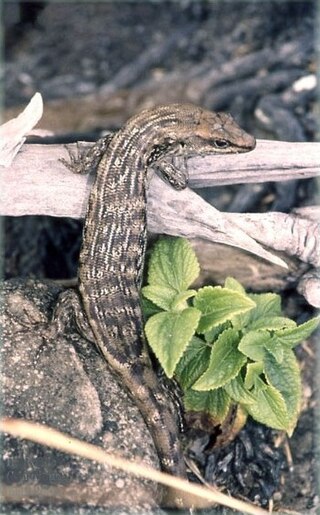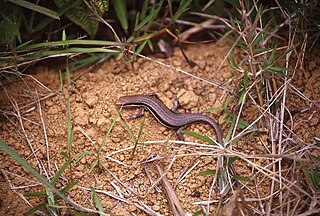Feylinia boulengeri is a species of skink, a lizard in the family Scincidae. The species is native to Central Africa.
Melanoseps is a genus of lizards, known commonly as limbless skinks, in the family Scincidae. The genus is endemic to Sub-Saharan Africa.
Sepsina is a genus of skinks. The genus is endemic to southern Africa.

Typhlosaurus is a genus of African lizards, one of a number of genera of limbless lizards in the skink family (Scincidae). This group was recently revised with most species formerly attributed to Typhlosaurus now placed in Acontias. The current definition of Typhlosaurus includes five attenuate body legless lizards from southwestern Africa. This is the sister genus to Acontias, which together form the well supported Afrotropical subfamily Acontinae.

Cunningham's spiny-tailed skink, also known commonly as Cunningham's skink, is a species of large skink, a lizard in the family Scincidae. The species is native to southeastern Australia.

Sphenomorphus dussumieri, commonly known as Dussumier's forest skink and Dussumier's litter skink, is a species of skink, a lizard in the family Scincidae. The species is endemic to southern India.

Leiolopisma telfairii, also known commonly as the Round Island ground skink, the Round Island skink, and Telfair's skink, is a species of lizard in the family Scincidae. The species is endemic to Round Island, one of the islands of Mauritius.

Gardiner's burrowing skink is a species of lizard in the family Scincidae. P. gardineri is the only species in the (monotypic) skink genus Pamelaescincus. The species is endemic to the Seychelles.

The fire skink, also known commonly as Fernand's skink, the Togo fire skink, and the true fire skink, is a fairly large skink, a species of lizard in the family Scincidae. The species is known for its bright and vivid coloration. Native to tropical forests in West and Central Africa, the fire skink lives fifteen to twenty years. This species is a diurnal lizard that burrows and hides. It is relatively shy and reclusive, but may become tame in captivity.
Trachylepis bayonii, also known commonly as Bayão's skink, Bayon's mabuya, and Bayon's skink, is a species of lizard in the family Scincidae. The species is endemic to Africa. There are two subspecies.

Lipinia pulchella, known commonly as the yellow-striped slender tree skink or beautiful lipinia, is a species of skink, a lizard in the family Scincidae. The species is endemic to the Philippines.
Chioninia delalandii is a species of skink, a lizard in the family Scincidae. The species is endemic to the Cape Verde Islands.

Lioscincus steindachneri, also known commonly as the white-lipped forest skink or Steindachner's ground skink, is a species of lizard in the family Scincidae. The species is endemic to New Caledonia.
Eumecia anchietae, also known commonly as Anchieta's serpentiform skink, Anchieta's snake skink, and the western serpentiform skink, is a species of lizard in the family Scincidae. The species is endemic to Africa. There are three recognized subspecies.

Trachylepis bocagii, also known commonly as Bocage's skink, is a species of lizard in the family Scincidae. The species is native to southern Africa.

Trachylepis gravenhorstii, also known commonly as Gravenhorst's mabuya, is a species of skink, a lizard in the family Scincidae. The species is endemic to Madagascar.
Feylinia currori, also known commonly as Curror's skink, the western forest feylinia, and the western forest limbless skink, is a species of lizard in the family Scincidae. The species is indigenous to Central Africa.
Sepsina bayonii, also known commonly as Bayon's skink, is a species of lizard in the family Scincidae. The species is native to Central Africa and Southern Africa.
Sepsina copei, also known commonly as Cope's reduced-limb skink or the sepsina skink, is a species of lizard in the family Scincidae. The species is endemic to Angola.
Typhlacontias punctatissimus, also known commonly as the dotted blind dart skink, the speckled burrowing skink, and the speckled western burrowing skink, is a species of lizard in the family Scincidae. The species is native to southern Africa. Three subspecies are recognized.










